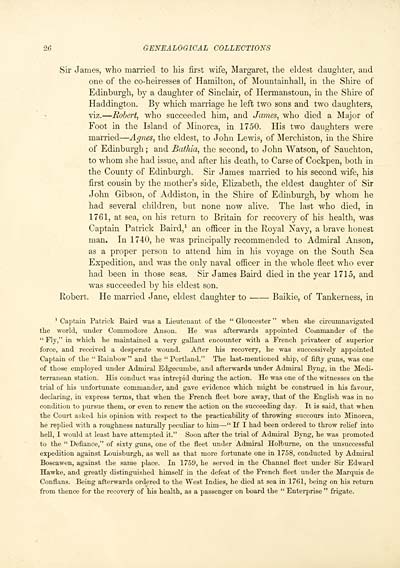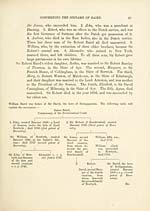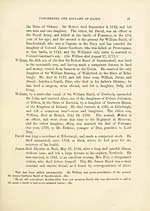Download files
Complete book:
Individual page:
Thumbnail gallery: Grid view | List view

26 GENEALOGICAL COLLECTIONS
Sir James, who married to his first wife, Margaret, the eldest daughter, and
one of the co-heiresses of Hamilton, of Mountainhall, in the Shire of
Edinburgh, by a daughter of Sinclair, of Hermanstoun, in the Shire of
Haddington. By which marriage he left two sons and two daughters,
viz. — Robert, who succeeded him, and James, who died a Major of
Foot in the Island of Minorca, in 1750. His two daughters were
married — Agnes, the eldest, to John Lewis, of Merchiston, in the Shire
of Edinburgh ; and Bathia, the second, to John Watson, of Sauchton,
to whom she had issue, and after his death, to Carse of Cockpen, both in
the County of Edinburgh. Sir James married to his second wife, his
first cousin by the mother's side, Elizabeth, the eldest daughter of Sir
John Gibson, of Addiston, in the Shire of Edinburgh, by whom he
had several children, but none now alive. The last who died, in
1761, at sea, on his return to Britain for recovery of his health, was
Captain Patrick Baird, 1 an officer in the Royal Navy, a brave honest
man. In 1740, he was principally recommended to Admiral Anson,
as a proper person to attend him in his voyage on the South Sea
Expedition, and was the only naval officer in the whole fleet who ever
had been in those seas. Sir James Baird died in the year 1715, and
was succeeded by his eldest son.
Robert. He married Jane, eldest daughter to Baikie, of Tankerness, in
1 Captain Patrick Baird was a Lieutenant of the " Gloucester " when she circumnavigated
the world, under Commodore Anson. He was afterwards appointed Commander of the
" Fly," in which he maintained a very gallant encounter with a French privateer of superior
force, and received a desperate wound. After his recovery, he was successively appointed
Captain of the " Kainbow " and the " Portland." The last-mentioned ship, of fifty guns, was one
of those employed under Admiral Edgecumbe, and afterwards under Admiral Byng, in the Medi-
terranean station. His conduct was intrepid during the action. He was one of the witnesses on the
trial of his unfortunate commander, and gave evidence which might he construed in his favour,
declaring, in express terms, that when the French fleet bore away, that of the English was in no
condition to pursue them, or even to renew the action on the succeeding day. It is said, that when
the Court asked his opinion with respect to the practicability of throwing succours into Minorca,
he replied with a roughness naturally peculiar to him — " If I had been ordered to throw relief into
hell, I would at least have attempted it." Soon after the trial of Admiral Byng, he was promoted
to the " Defiance," of sixty guns, one of the fleet under Admiral Holburne, on the unsuccessful
expedition against Louisburgh, as well as that more fortunate one in 1 758, conducted by Admiral
Boscawen, against the same place. In 1759, he served in the Channel fleet under Sir Edward
Hawke, and greatly distinguished himself in the defeat of the French fleet under the Marquis de
Conflans. Being afterwards ordered to the West Indies, he died at sea in 1761, being on his return
from thence for the recovery of his health, as a passenger on board the " Enterprise " frigate.
Sir James, who married to his first wife, Margaret, the eldest daughter, and
one of the co-heiresses of Hamilton, of Mountainhall, in the Shire of
Edinburgh, by a daughter of Sinclair, of Hermanstoun, in the Shire of
Haddington. By which marriage he left two sons and two daughters,
viz. — Robert, who succeeded him, and James, who died a Major of
Foot in the Island of Minorca, in 1750. His two daughters were
married — Agnes, the eldest, to John Lewis, of Merchiston, in the Shire
of Edinburgh ; and Bathia, the second, to John Watson, of Sauchton,
to whom she had issue, and after his death, to Carse of Cockpen, both in
the County of Edinburgh. Sir James married to his second wife, his
first cousin by the mother's side, Elizabeth, the eldest daughter of Sir
John Gibson, of Addiston, in the Shire of Edinburgh, by whom he
had several children, but none now alive. The last who died, in
1761, at sea, on his return to Britain for recovery of his health, was
Captain Patrick Baird, 1 an officer in the Royal Navy, a brave honest
man. In 1740, he was principally recommended to Admiral Anson,
as a proper person to attend him in his voyage on the South Sea
Expedition, and was the only naval officer in the whole fleet who ever
had been in those seas. Sir James Baird died in the year 1715, and
was succeeded by his eldest son.
Robert. He married Jane, eldest daughter to Baikie, of Tankerness, in
1 Captain Patrick Baird was a Lieutenant of the " Gloucester " when she circumnavigated
the world, under Commodore Anson. He was afterwards appointed Commander of the
" Fly," in which he maintained a very gallant encounter with a French privateer of superior
force, and received a desperate wound. After his recovery, he was successively appointed
Captain of the " Kainbow " and the " Portland." The last-mentioned ship, of fifty guns, was one
of those employed under Admiral Edgecumbe, and afterwards under Admiral Byng, in the Medi-
terranean station. His conduct was intrepid during the action. He was one of the witnesses on the
trial of his unfortunate commander, and gave evidence which might he construed in his favour,
declaring, in express terms, that when the French fleet bore away, that of the English was in no
condition to pursue them, or even to renew the action on the succeeding day. It is said, that when
the Court asked his opinion with respect to the practicability of throwing succours into Minorca,
he replied with a roughness naturally peculiar to him — " If I had been ordered to throw relief into
hell, I would at least have attempted it." Soon after the trial of Admiral Byng, he was promoted
to the " Defiance," of sixty guns, one of the fleet under Admiral Holburne, on the unsuccessful
expedition against Louisburgh, as well as that more fortunate one in 1 758, conducted by Admiral
Boscawen, against the same place. In 1759, he served in the Channel fleet under Sir Edward
Hawke, and greatly distinguished himself in the defeat of the French fleet under the Marquis de
Conflans. Being afterwards ordered to the West Indies, he died at sea in 1761, being on his return
from thence for the recovery of his health, as a passenger on board the " Enterprise " frigate.
Set display mode to:
![]() Universal Viewer |
Universal Viewer | ![]() Mirador |
Large image | Transcription
Mirador |
Large image | Transcription
Images and transcriptions on this page, including medium image downloads, may be used under the Creative Commons Attribution 4.0 International Licence unless otherwise stated. ![]()
| Histories of Scottish families > Genealogical collections concerning the sir-name of Baird, and the families of Auchmedden, Newbyth, and Sauchton Hall in particular > (50) Page 26 |
|---|
| Permanent URL | https://digital.nls.uk/95362303 |
|---|
| Description | A selection of almost 400 printed items relating to the history of Scottish families, mostly dating from the 19th and early 20th centuries. Includes memoirs, genealogies and clan histories, with a few produced by emigrant families. The earliest family history goes back to AD 916. |
|---|

